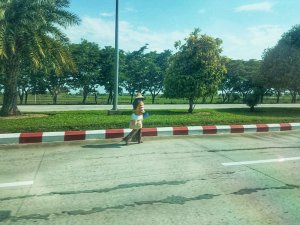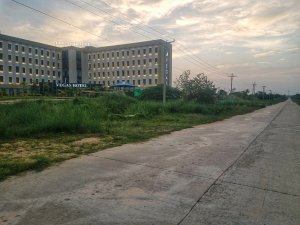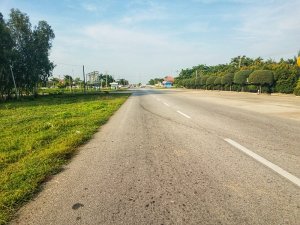Naypyidaw is one of the strangest cities in the world. The new capital of Myanmar, Naypyidaw is not the scene travelers anticipate finding in most national capitals.

The peculiar nature of this city has drawn attention in recent years, as travelers are curious to witness an enormous, modern ghost town for themselves. But is Naypyidaw really worth a visit?
Prior to visiting Naypyidaw, my research indicated that the city is home to about a million people. Despite that, it was said to be an empty, modern ghost town in the middle of Myanmar.

My intrigue and curiosity led me to Naypyidaw. What I found is certainly curious, but little more than an empty city whose appearance is maintained for the few people within its limits.
Naypyidaw, the New Capital of Myanmar
Before traveling to Naypyidaw, it might be wise to understand the situation of the city. It is best in Myanmar to not ask too many questions concerning the state of the government, and that is a practice that you don’t want to test while in the government city.
In the 2000s, the government of Myanmar decided to move the national capital from Yangon to a new city called Nay Pyi Taw.
Yangon (Rangoon) was the capital of Myanmar (formerly Burma) since the country’s days as a British colony. Yangon is an enormous city with more than seven million inhabitants. It is the center of transportation, media and also the economic center of Myanmar.
The reasons behind moving the capital of Myanmar to Naypyidaw are vague, and speculation over the decision ranges across a variety of possible reasons. Regardless, the result is that the government of Myanmar is now officially headquartered in Naypyidaw.
Myanmar’s capital is not the first in modern times to relocate to a planned city. Although the decision is perplexing, it will take several years, more likely decades, to determine if the relocation is a good idea.
Traveling Around Naypyidaw: Good Luck
Transportation in Myanmar is a challenge. As previously mentioned in my guides to Mandalay and Bagan, the challenge is interesting and can be fun. In Naypyidaw, transportation is nothing more than a headache.
If you do manage to find something to see or do, getting there is a pain in the ass. Naypyidaw is so spread out that walking is rarely a practical option. I’m an advocate of walking whenever possible, but I would never suggest walking in areas not fit for pedestrians. Add these crazy distances to the Burmese weather, which can range from blistering heat to a raging thunderstorm in an afternoon, walking is not practical in Naypyidaw.

Public transportation, unless I missed it, does not exist in Myanmar’s capital. There are no city buses, and taxis are nowhere to be seen. Local transportation like motorbikes and tuk tuks are almost entirely absent (by law) from the city.
If you do need to get somewhere in Naypyidaw, you will have to arrange a taxi through the hotel. Transportation in the city is a budget-buster and a headache.
Naypyidaw, the Ghost Town of Myanmar
Naypyidaw is a strange place. I can’t stress that enough. The city is enormous but empty. Local hotel staff are very friendly, but local citizens seem reluctant to communicate with foreigners, perhaps due to the government-centric nature of the city. This only adds to the mysterious vibe in town.
Aside from government presence, there is not much else in Naypyidaw. It really is a massive ghost town. The photos of huge 16-lane highways completely devoid of traffic are accurate. And the smaller roads off of these larger thoroughfares are also pretty much empty.
Apparently, some businessmen believe that Naypyidaw will soon see substantial growth. For a city with no real attraction, there are a lot of hotels. These hotels aren’t the small, worn and local hotels found in Mandalay or Yangon. Hotels in Naypyidaw feel like fancy hotels in the United States – large properties with high ceilings and stately lobbies – that are usually full of business travelers. In Naypyidaw, these hotels are empty.

I spent three nights in a very nice hotel in Naypyidaw. There are no hostels in the city, and hotels are the only option. This particular hotel is nice by any standards. Staff was friendly. The property had excellent WiFi and a good breakfast. But it was empty. This nearly-300-room property had, at most, ten total guests. And this appeared to be the case at every hotel I saw in Naypyidaw. Large, nice and empty. I can only imagine how they manage to stay in business.
Aside from curiously empty hotels, eating in Naypyidaw is a serious challenge. There are not many restaurant options, and it is unlikely you will be able to walk to dinner in the sprawling city. Most restaurants are near, or associated with, hotels. The result is overpriced food. In a country with good, affordable food, restaurants in Naypyidaw are significantly more expensive than other parts of the country.

There are cool sights in Naypyidaw. Unfortunately, a lot of these are off-limits to visitors. There are cool markets, but they are far away from the tourist zone, usually in villages outside of Naypyidaw. There is even a massive pagoda. But all of these things can be found in other destinations that offer travelers a lot more to explore.
The ghost town idea of Naypyidaw is intriguing. In practice, it is challenging. With limited activities and attractions for tourists, travelers should think twice before planning a stay in the Myanmar capital.
Overpriced & Expensive
Naypyidaw is an expensive city. Hotel prices, although not as expensive as more developed nations, are not in line with the overall affordability of travel in Myanmar. Regardless of price quotes you find online, expect a tourist tax and occupancy tax to be added to your hotel bill.
Food is considerably more expensive than Yangon or Mandalay. If you’re thinking of saving some money by eating at a mini-mart for your duration in Naypyidaw, good luck. There are no mini-marts in the tourist zone.
I believe Naypyidaw is designed to be expensive. The city is a project of an already-controlling government and certainly cost the country a fortune. By passing on the cost to visitors, government is hoping to recoup the losses. The only problem is that no one is going to Naypyidaw.
Naypyidaw: Should You Go?
Naypyidaw would have been a great idea a century or two ago. In many ways, the city is planned well. The infrastructure is great for Southeast Asia. However, the idea for a country with a large population to build a new capital in modern times is risky. While politics are liberalizing and personal freedoms are improving, the oppressive and controversial government of Myanmar-past seems to maintain a stronghold in Naypyidaw.

The stories of travelers wandering around this huge, modern ghost town got me. My intrigue was captured and Naypyidaw was a sight I could not wait to see in Myanmar. That was a mistake. Reading those other stories is sufficient.
Before traveling to Naypyidaw, consider that it is an expensive place to go and there is not much to do. Getting around the city is a challenge and, aside from the emptiness, there is not much uniqueness to this city.
Should you travel to Myanmar? Absolutely. This country is fun and interesting. It is a relatively cheap travel destination with wonderful people.
As for Naypyidaw, skip the capital city. Travel in Myanmar is better spent in wandering in Yangon, exploring Bagan or relaxing on the Andaman Sea.
The suggestion that the prices are high in NPD due to the cost of building a new city is not right I think. It is just the hotels and restaurants know there are no any other options so they can ask an inflated price. A good way to go around there is by motorbike I think, you can rent them from some hotels. Also at inflated price (in comparison to Rangoon or Madalay) but more affordable then taxi service.
I’m not so sure about that. I spent several days here, and I don’t think I saw any motorbikes in the city center… Unless the hotels and restaurants are supported financially by the government, the high prices are indeed to cover building costs, because there’s no way there’s enough revenue to be anywhere close to profitable. And regardless of the reason for high prices, they are unnecessarily high.
Also mainly business / government travellers will stay there and the company will pay the bill so expenses will not be an issue like in a tourist area. And do not forget most hotels do have a very low occupancy rate, so actual cost per pax will be higher. But thank you for your posting, very intersting. I will go the place next March, heading to Mandalay. Not sure yet if I will go by train or bus.
The cost may not matter to most business and government travelers, but a lot of people are curious about this huge ghost city. And backpackers, who make up a lot of the foreign tourists in Myanmar, aren’t looking to drop a lot of money on a hotel. So, I’m trying to help potential backpackers and budget travelers (and other curious readers, of course)… Anyway, enjoy your trip in March! As a whole, I love Myanmar. One of my favorite countries and I can’t wait to go back. Even to NPD, I want to return. Have fun!